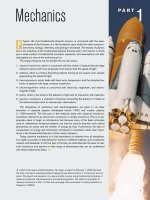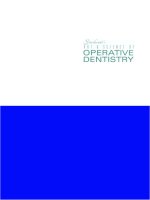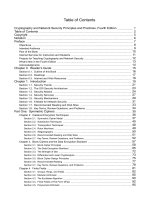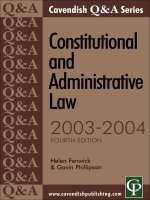Intermediate Physics for Medicine and Biology - Fourth Edition ppt
Bạn đang xem bản rút gọn của tài liệu. Xem và tải ngay bản đầy đủ của tài liệu tại đây (980.74 KB, 115 trang )
P1: IML/FFX P2: IML/FFX QC: IML/FFX T1: IML
MOBK041-FM MOBK041-Enderle.cls October 27, 2006 7:26
Intermediate Probability Theory
for Biomedical Engineers
i
Copyright © 2006 by Morgan & Claypool
All rights reserved. No part of this publication may be reproduced, stored in a retrieval system, or transmitted in
any form or by any means—electronic, mechanical, photocopy, recording, or any other except for brief quotations
in printed reviews, without the prior permission of the publisher.
Intermediate Probability Theory for Biomedical Engineers
John D. Enderle, David C. Farden, and Daniel J. Krause
www.morganclaypool.com
ISBN-10: 1598291408 paperback
ISBN-13: 9781598291407 paperback
ISBN-10: 1598291416 ebook
ISBN-13: 9781598291414 ebook
DOI10.2200/S00062ED1V01Y200610BME010
A lecture in the Morgan & Claypool Synthesis Series
SYNTHESIS LECTURES ON BIOMEDICAL ENGINEERING #10
Lecture #10
Series Editor: John D. Enderle, University of Connecticut
Series ISSN: 1930-0328 print
Series ISSN: 1930-0336 electronic
First Edition
10 9 8 7 6 5 4 3 2 1
Printed in the United States of America
P1: IML/FFX P2: IML/FFX QC: IML/FFX T1: IML
MOBK041-FM MOBK041-Enderle.cls October 27, 2006 7:26
Intermediate Probability Theory
for Biomedical Engineers
John D. Enderle
Program Director & Professor for Biomedical Engineering
University of Connecticut
David C. Farden
Professor of Electrical and Computer Engineering
North Dakota State University
Daniel J. Krause
Emeritus Professor of Electrical and Computer Engineering
North Dakota State University
SYNTHESIS LECTURES ON BIOMEDICAL ENGINEERING #10
M
&C
Morgan
&
Claypool Publishers
iii
P1: IML/FFX P2: IML/FFX QC: IML/FFX T1: IML
MOBK041-FM MOBK041-Enderle.cls October 27, 2006 7:26
iv
ABSTRACT
This is the second in a series of three short books on probability theory and random processes for
biomedical engineers. This volume focuses on expectation, standard deviation, moments, and the
characteristic function. In addition, conditional expectation, conditional moments and the conditional
characteristic function are also discussed. Jointly distributed random variables are described, along
with joint expectation, joint moments, and the joint characteristic function. Convolution is also
developed. A considerable effort has been made to develop the theory in a logical manner—
developing special mathematical skills as needed. The mathematical background required of the
reader is basic knowledge of differential calculus. Every effort has been made to be consistent
with commonly used notation and terminology—both within the engineering community as
well as the probability and statistics literature. The aim is to prepare students for the application
of this theory to a wide variety of problems, as well give practicing engineers and researchers a
tool to pursue these topics at a more advanced level. Pertinent biomedical engineering examples
are used throughout the text.
KEYWORDS
Probability Theory, Random Processes, Engineering Statistics, Probability and Statistics for
Biomedical Engineers, Statistics. Biostatistics, Expectation, Standard Deviation, Moments,
Characteristic Function
P1: IML/FFX P2: IML/FFX QC: IML/FFX T1: IML
MOBK041-FM MOBK041-Enderle.cls October 27, 2006 7:26
v
Contents
3. Expectation 1
3.1 Moments 2
3.2 Bounds on Probabilities 10
3.3 Characteristic Function 14
3.4 Conditional Expectation 23
3.5 Summary 25
3.6 Problems 26
4. Bivariate Random Variables 33
4.1 Bivariate CDF 33
4.1.1 Discrete Bivariate Random Variables 39
4.1.2 Bivariate Continuous Random Variables 43
4.1.3 Bivariate Mixed Random Variables 49
4.2 Bivariate Riemann-Stieltjes Integral. . 53
4.3 Expectation 57
4.3.1 Moments 58
4.3.2 Inequalities 62
4.3.3 Joint Characteristic Function. 64
4.4 Convolution 66
4.5 Conditional Probability 71
4.6 Conditional Expectation 78
4.7 Summary 85
4.8 Problems 86
P1: IML/FFX P2: IML/FFX QC: IML/FFX T1: IML
MOBK041-FM MOBK041-Enderle.cls October 27, 2006 7:26
vi
P1: IML/FFX P2: IML/FFX QC: IML/FFX T1: IML
MOBK041-FM MOBK041-Enderle.cls October 27, 2006 7:26
vii
Preface
This is the second in a series of short books on probability theory and random processes for
biomedical engineers. This text is written as an introduction to probability theory. The goal was
to prepare students at the sophomore, junior or senior level for the application of this theory to a
wide variety of problems—as well as pursue these topics at a more advanced level. Our approach
is to present a unified treatment of the subject. There are only a few key concepts involved in the
basic theory of probability theory. These key concepts are all presented in the first chapter. The
second chapter introduces the topic of random variables. Later chapters simply expand upon
these key ideas and extend the range of application.
This short book focuses on expectation, standard deviation, moments, and the character-
istic function. In addition, conditional expectation, conditional moments and the conditional
characteristic function are also discussed. Jointly distributed random variables are described,
along with joint expectation, joint moments, and the joint characteristic function. Convolution
is also developed.
A considerable effort has been made to develop the theory in a logical manner—
developing special mathematical skills as needed. The mathematical background required of the
reader is basic knowledge of differential calculus. Every effort has been made to be consistent
with commonly used notation and terminology—both within the engineering community as
well as the probability and statistics literature.
The applications and examples given reflect the authors’ background in teaching prob-
ability theory and random processes for many years. We have found it best to introduce this
material using simple examples such as dice and cards, rather than more complex biological
and biomedical phenomena. However, we do introduce some pertinent biomedical engineering
examples throughout the text.
Students in other fields should also find the approach useful. Drill problems, straightfor-
ward exercises designed to reinforce concepts and develop problem solution skills, follow most
sections. The answers to the drill problems follow the problem statement in random order.
At the end of each chapter is a wide selection of problems, ranging from simple to difficult,
presented in the same general order as covered in the textbook.
We acknowledge andthank William Pruehsner for the technicalillustrations. Many of the
examples and end of chapter problems are based on examples from the textbook by Drake [9].
P1: IML/FFX P2: IML/FFX QC: IML/FFX T1: IML
MOBK041-FM MOBK041-Enderle.cls October 27, 2006 7:26
viii
P1: IML/FFX P2: IML/FFX QC: IML/FFX T1: IML
MOBK041-03 MOBK041-Enderle.cls October 27, 2006 7:20
1
CHAPTER 3
Expectation
Suppose that an experiment is performed N times and the RV x is observed to take on the value
x = x
i
on the ith trial, i = 1, 2, ,N. The average of these N numbers is
x
N
=
1
N
N
i=1
x
i
. (3.1)
We anticipate that as N →∞, the average observed value of the RV x would converge to a
constant, say
x. It is important to note that such sums do not always converge; here, we simply
appeal to one’s intuition to suspect that convergence occurs. Further, we have the intuition that
the value
x can be computed if the CDF F
x
is known. For example, if a single die is tossed a
large number of times, we expect that the average value on the face of the die would approach
1
6
(1 + 2 + 3 + 4 +5 +6) = 3.5.
For this case we predict
x =
6
i=1
iP(x = i) =
∞
−∞
α dF
x
(α). (3.2)
A little reflection reveals that this computation makes sense even for continuous RVs: the
predicted value for
x should be the “sum” of all possible values the RV x takes on weighted by
the “relative frequency” or probability the RV takes on that value. Similarly, we predict that the
average observed value of a function of x,sayg(x), to be
g(x) =
∞
−∞
g(α) dF
x
(α) . (3.3)
Of course, whether or not this prediction is realized when the experiment is performed a
large number of times depends on how well our model for the experiment (which is based on
probability theory) matches the physical experiment.
P1: IML/FFX P2: IML/FFX QC: IML/FFX T1: IML
MOBK041-03 MOBK041-Enderle.cls October 27, 2006 7:20
2 INTERMEDIATE PROBABILITY THEORY FOR BIOMEDICAL ENGINEERS
Thestatisticalaverage operationperformedto obtain g(x)iscalledstatisticalexpectation.
The sample average used to estimate
x with x
N
is called the sample mean. The quality of
estimate attained by a sample mean operation is investigated in a later chapter. In this chapter,
we present definitions and properties of statistical expectation operations and investigate how
knowledge of certain moments of a RV provides useful information about the CDF.
3.1 MOMENTS
Definition 3.1.1. The expected value of g(x) is defined by
E(g(x)) =
∞
−∞
g(α) dF
x
(α) , (3.4)
provided the integral exists. The mean of the RV x is defined by
η
x
= E(x) =
∞
−∞
α dF
x
(α). (3.5)
The variance of the RV x is defined by
σ
2
x
= E((x − η
x
)
2
), (3.6)
and the nonnegative quantity σ
x
is called the standard deviation. The nth moment and the nth
central moment, respectively, are defined by
m
n
= E(x
n
) (3.7)
and
μ
n
= E((x − η
x
)
n
). (3.8)
The expected value of g(x) provides some information concerning the CDF F
x
. Knowledge of
E(g(x)) does not, in general, enable F
x
to be determined—but there are exceptions. For any
real value of α,
E(u(α − x)) =
∞
−∞
u(α −α
) dF
x
(α
) =
α
−∞
dF
x
(α
) = F
x
(α). (3.9)
The sample mean estimate for E(u(α −x)) is
1
n
n
i=1
u(α − x
i
),
P1: IML/FFX P2: IML/FFX QC: IML/FFX T1: IML
MOBK041-03 MOBK041-Enderle.cls October 27, 2006 7:20
EXPECTATION 3
the empirical distribution function discussed in Chapter 2. If α ∈
∗
and x is a continuous RV
then (for all α where f
x
is continuous)
E(δ(α − x)) =
∞
−∞
δ(α −α
) f
x
(α
) dα
= f
x
(α). (3.10)
Let A be an event on the probability space (S, F, P), and let
I
A
(ζ ) =
1, if ζ ∈ A
0, otherwise.
(3.11)
With x(ζ ) = I
A
(ζ ), x is a legitimate RV with x
−1
({1}) = A and x
−1
({0}) = A
c
. Then
E(x) =
∞
−∞
α dF
x
(α) = P(A). (3.12)
The above result may also be written in terms of the Lebesgue-Stieltjes integral as
E(I
A
(ζ )) =
ζ ∈S
I
A
(ζ )dP(ζ) =
A
dP(ζ) = P(A). (3.13)
The function I
A
is often called an indicator function.
If one interprets a PDF f
x
as a “mass density”, then the mean E(x) has the interpretation
of the center of gravity, E(x
2
) becomes the moment of inertia about the origin, and the variance
σ
2
x
becomes the central moment of inertia. The standard deviation σ
x
becomes the radius of
gyration. A small value of σ
2
x
indicates that most of the mass (probability) is concentrated at
the mean; i.e., x(ζ ) ≈ η
x
with high probability.
Example 3.1.1. The RV x has the PMF
p
x
(α) =
⎧
⎪
⎪
⎪
⎪
⎪
⎪
⎨
⎪
⎪
⎪
⎪
⎪
⎪
⎩
1
4
,α= b −a
1
4
,α= b +a
1
2
,α= b
0, otherwise,
where a and b are real constants with a > 0. Find the mean and variance for x.
Solution. We obtain
η
x
= E(x) =
∞
−∞
α dF
x
(α) =
b − a
4
+
b
2
+
b + a
4
= b
P1: IML/FFX P2: IML/FFX QC: IML/FFX T1: IML
MOBK041-03 MOBK041-Enderle.cls October 27, 2006 7:20
4 INTERMEDIATE PROBABILITY THEORY FOR BIOMEDICAL ENGINEERS
and
σ
2
x
= E((x − η
x
)
2
) =
∞
−∞
(α −η
x
)
2
dF
x
(α) =
a
2
2
.
Example 3.1.2. The RV x has PDF
f
x
(α) =
1
b − a
(u(α −a) −u(α −b))
where a and b are real constants with a < b. Find the mean and variance for x.
Solution. We have
E(x) =
1
b − a
b
a
α dα =
b
2
− a
2
2(b − a)
=
b + a
2
and
σ
2
x
=
1
b − a
b
a
α −
b + a
2
2
dα =
1
b − a
(b−a)/2
−(b−a)/2
β
2
dβ =
(b − a)
2
12
.
Example 3.1.3. Find the expected value of g(x) = 2x
2
− 1, where
f
x
(α) =
⎧
⎨
⎩
1
3
α
2
, −1 <α<2
0, otherwise.
Solution. By definition,
E(g(x)) =
+∞
−∞
g(α) f
x
(α) dα =
1
3
2
−1
(2α
2
− 1)α
2
dα =
17
5
.
Example 3.1.4. The RV x has PDF
f
x
(α) =
1.5(1 − α
2
), 0 ≤ α<1
0, elsewhere.
Find the mean, the second moment, and the variance for the RV x.
Solution. From the definition of expectation,
η
x
= E(x) =
∞
−∞
α f
x
(α) dα =
3
2
1
0
(α −α
3
) dα =
3
8
.
P1: IML/FFX P2: IML/FFX QC: IML/FFX T1: IML
MOBK041-03 MOBK041-Enderle.cls October 27, 2006 7:20
EXPECTATION 5
Similarly, the second moment is
m
2
= E(x
2
) =
∞
−∞
α
2
f
x
(α) dα =
3
2
1
0
(α
2
− α
4
) dα =
3
2
5 − 3
15
=
1
5
.
Applying the definition of variance,
σ
2
x
=
1
0
α −
3
8
2
3
2
(1 − α
2
) dα.
Instead of expanding the integrand directly, it is somewhat easier to use the change of variable
β = α −
3
8
, to obtain
σ
2
x
=
3
2
5/8
−3/8
55
64
β
2
−
3
4
β
3
− β
4
dβ = 0.059375.
The following theorem and its corollary provide an easier technique for finding the variance.
The result of importance here is
σ
2
x
= E(x
2
) − η
2
x
=
1
5
−
3
8
2
=
19
320
= 0.059375.
The PDF for this example is illustrated in Fig. 3.1. Interpreting the PDF as a mass density
along the abscissa, the mean is the center of gravity. Note that the mean always falls between
the minimum and maximum values for which the PDF is nonzero.
The following theorem establishes that expectation is a linear operation and that the
expected value of a constant is the constant.
a
0
1
2
1
f
x
(a)
1
3
2
FIGURE 3.1: PDF for Example 3.1.4.
P1: IML/FFX P2: IML/FFX QC: IML/FFX T1: IML
MOBK041-03 MOBK041-Enderle.cls October 27, 2006 7:20
6 INTERMEDIATE PROBABILITY THEORY FOR BIOMEDICAL ENGINEERS
Theorem 3.1.1. The expectation operator satisfies
E(a) = a (3.14)
and
E(a
1
g
1
(x) + a
2
g
2
(x)) = a
1
E(g
1
(x)) + a
2
E(g
2
(x)), (3.15)
where a, a
1
, and a
2
are arbitrary constants and we have assumed that all indicated integrals exist.
Proof. The desired results follow immediately from the properties of the Riemann-Stieltjes
integral and the definition of expectation.
Applying the above theorem, we find
σ
2
x
= E((x − η
x
)
2
) = E(x
2
− 2η
x
x +η
2
x
) = E(x
2
) − η
2
x
, (3.16)
as promised in Example 3.1.4. The following corollary provides a general relationship between
moments and central moments.
Corollary 3.1.1. The nth central moment for the RV x can be found from the moments {m
0
,
m
1
, ,m
n
} as
μ
n
= E((x − η
x
)
n
) =
n
k=0
n
k
m
k
(−η
x
)
n−k
. (3.17)
Similarly, the nth moment for the RV x can be found from the central moments {μ
0
,μ
1
, ,μ
n
} as
m
n
= E(x
n
) =
n
k=0
n
k
μ
k
(η
x
)
n−k
. (3.18)
Proof. From the Binomial Theorem, we have for any real constant a:
(x −a)
n
=
n
k=0
n
k
x
k
(−a)
n−k
and
x
n
= ((x − a) + a)
n
=
n
k=0
n
k
(x −a)
k
a
n−k
.
Taking the expected valueof both sides of theabove equations and usingthe fact that expectation
is a linear operation, the desired results follow by choosing a = η
x
.
P1: IML/FFX P2: IML/FFX QC: IML/FFX T1: IML
MOBK041-03 MOBK041-Enderle.cls October 27, 2006 7:20
EXPECTATION 7
In many advanced treatments of probability theory (e.g. [4, 5, 11]), expectation is defined in
terms of the Lebesgue-Stieltjes integral
E(g(x)) =
S
g(x(ζ )) dP(ζ ). (3.19)
In most cases (whenever the Lebesgue-Stieltjes integral and the Riemann-Stieltjes integral both
exist) the two definitions yield identical results. The existence of the Lebesgue-Stieltjes integral
(3.19) requires
E(|g(x)|) =
S
|g(x(ζ ))|dP(ζ ) < ∞, (3.20)
whereas the Riemann-Stieltjes integral (3.4) may exist even though
E(|g(x)|) =
∞
−∞
|g(α)|dF
x
(α) =∞. (3.21)
Consequently, using (3.4) as a definition, we will on occasion arrive at a value for E(g(x)) in
cases where E(|g(x)|) =∞. There are applications for which this more liberal interpretation is
useful.
Example 3.1.5. Find the mean and variance of the RV x with PDF
f
x
(α) =
1
π(1 + α
2
)
.
Solution. By definition,
η
x
= lim
T
1
,T
2
→∞
T
2
−T
1
α f
x
(α) dα,
assuming the limit exists independent of the manner in which T
1
→∞and T
2
→∞. For this
example, we have
T
2
−T
1
α f
x
(α) dα =
1
2π
(ln(1 + T
2
2
) − ln(1 + T
2
1
)).
Consequently, the limit indicated above does not exist. If we restrict the limit to the form
T
1
= T
2
= T (corresponding to the Cauchy principle value of the integral) then we obtain
P1: IML/FFX P2: IML/FFX QC: IML/FFX T1: IML
MOBK041-03 MOBK041-Enderle.cls October 27, 2006 7:20
8 INTERMEDIATE PROBABILITY THEORY FOR BIOMEDICAL ENGINEERS
η
x
= 0. Accepting η
x
= 0 for the mean, we find
E(x
2
) = lim
T
1
,T
2
→∞
T
2
−T
1
α
2
f
x
(α) dα =+∞,
and we conclude that σ
2
x
=∞.
The computation of high order moments using the direct application of the definition
(3.4) is often tedious. We now explore some alternatives.
Example 3.1.6. The RV x has PDF f
x
(α) = e
−α
u(α). Express m
n
intermsofm
n−1
for n =
1, 2,
Solution. By definition, we have
m
n
= E(x
n
) =
∞
0
α
n
e
−α
dα.
Integrating by parts (with u = α
n
and dv = e
−α
dα)
m
n
=−α
n
e
−α
∞
0
+ n
∞
0
α
n−1
e
−α
dα = nm
n−1
, n = 1, 2,
Note that m
0
= E(1) = 1. For example, we have m
4
= 4 ·3 ·2 · 1 = 4!. We have used the fact
that for n > 0
lim
α→∞
α
n
e
−α
= 0.
This can be shown by using the Taylor series for e
α
to obtain
α
n
e
α
=
α
n
∞
k=0
α
k
k!
≤
α
n
α
n+1
(n + 1)!
=
(n + 1)!
α
The above example illustrates one technique for avoiding tedious repeated integration by parts.
The moment generating function provides another frequently useful escape, trading repeated
integration by parts with repeated differentiation.
Definition 3.1.2. The function
M
x
(λ) = E(e
λx
) (3.22)
is called the moment generating function for the RV x, where λ is a real variable.
P1: IML/FFX P2: IML/FFX QC: IML/FFX T1: IML
MOBK041-03 MOBK041-Enderle.cls October 27, 2006 7:20
EXPECTATION 9
Although the moment generating function does not always exist, when it does exist, it is useful
for computing moments for a RV, as shown below. In Section 3.3 we introduce a related
function, the characteristic function. The characteristic function always exists and can also be
used to obtain moments.
Theorem 3.1.2. Let M
x
(λ) be the moment generating function for the RV x, and assume M
(n)
x
(0)
exists, where
M
(n)
x
(λ) =
d
n
M
x
(λ)
dλ
n
. (3.23)
Then
E(x
n
) = M
(n)
x
(0). (3.24)
Proof. Noting that
d
n
e
λx
dλ
n
= x
n
e
λx
we have M
(n)
x
(λ) = E(x
n
e
λx
). The desired result follows by evaluating at λ = 0.
Example 3.1.7. The RV x has PDF f
x
(α) = e
−α
u(α). Find M
x
(λ) and E(x
n
), where n is a
positive integer.
Solution. We find
M
x
(λ) =
∞
0
e
(λ−1)α
dα =
1
1 − λ
,
provided that λ<1. Straightforward computation reveals that
M
(n)
x
(λ) =
n!
(1 − λ)
n+1
;
hence, E(x
n
) = M
(n)
x
(0) = n!.
Drill Problem 3.1.1. The RV x has PMF shown in Fig. 3.2. Find (a) E(x), (b)E(x
2
), and (c)
E((x −2.125)
2
).
Answers:
199
64
,
61
8
,
17
8
.
DrillProblem3.1.2. We given E(x) = 2.5and E(y) = 10.Determine:(a) E(3x + 4), (b)E(x +
y), and (c) E(3x +8y +5).
Answers: 12.5, 92.5, 11.5.
P1: IML/FFX P2: IML/FFX QC: IML/FFX T1: IML
MOBK041-03 MOBK041-Enderle.cls October 27, 2006 7:20
10 INTERMEDIATE PROBABILITY THEORY FOR BIOMEDICAL ENGINEERS
α
0 1234
5
p
x
(a)
3
8
2
8
1
8
FIGURE 3.2: PMF for Drill Problem 3.1.1.
Drill Problem 3.1.3. The PDF for the RV x is
f
x
(α) =
3
8
(
√
α +
1
√
α
), 0 <α<1
0, elsewhere.
Find (a) E(x), and (b) σ
2
x
.
Answers:
17
175
,
2
5
.
Drill Problem 3.1.4. The RV x has variance σ
2
x
. Define the RVs y and z as y = x +b, and
z = ax, where a and b are real constants. Find σ
2
y
and σ
2
z
.
Answers: σ
2
x
, a
2
σ
2
x
.
Drill Problem 3.1.5. The RV x has PDF f
x
(α) =
1
2
e
−|α|
. Find (a) M
x
(λ), (b)η
x
, and (c) σ
2
x
.
Answers: 2; 0; (1 − λ
2
)
−1
, for |λ| < 1.
3.2 BOUNDS ON PROBABILITIES
In practice, one often has good estimates of some moments of a RV without having knowledge
of the CDF. In this section, we investigate some important inequalities which enable one
to establish bounds on probabilities which can be used when the CDF is not known. These
bounds are also useful for gaining a “feel” for the information about the CDF contained in
various moments.
Theorem 3.2.1. (Generalized Chebyshev Inequality) Let x be a RV on (S, , P), and let
ψ :
∗
→
∗
be strictly positive, even, nondecreasing on (0, ∞], with E(ψ(x)) < ∞. Then for
each x
0
> 0:
P(|x(ζ )|≥x
0
) ≤
E(ψ(x))
ψ(x
0
)
. (3.25)
P1: IML/FFX P2: IML/FFX QC: IML/FFX T1: IML
MOBK041-03 MOBK041-Enderle.cls October 27, 2006 7:20
EXPECTATION 11
Proof. Let x
0
> 0. Then
E(ψ(x)) =
∞
−∞
ψ(α) dF
x
(α)
=
|α|<x
0
ψ(α)dF
x
(α) +
|α|≥x
0
ψ(α)dF
x
(α)
=
|α|≥x
0
ψ(α)dF
x
(α)
≥ ψ(x
0
)
|α|≥x
0
dF
x
(α)
= ψ(x
0
)P(|x(ζ)|≥x
0
).
Corollary 3.2.1. (Markov Inequality) LetxbeaRVon(S, F, P), x
0
> 0, and r > 0. Then
P(|x(ζ )|≥x
0
) ≤
E(|x(ζ )|
r
)
x
r
0
. (3.26)
Proof. The result follows from Theorem 1 with ψ(x) =|x|
r
.
Corollary 3.2.2. (Chebyshev Inequality) LetxbeaRVon(S, , P) with standard deviation
σ
x
, and let α>0. Then
P(|x(ζ ) − η
x
|≥ασ
x
) ≤
1
α
2
. (3.27)
Proof. The desired result follows by applying the Markov Inequality to the RV x −η
x
with
r = 2 and x
0
= ασ
x
.
Example 3.2.1. Random variable x has a mean and a variance of four, but an otherwise unknown
CDF. Determine a lower bound on P(|x − 4| < 8) using the Chebyshev Inequality.
Solution. We have
P(|x −4|≥8) = P(|x −η
x
|≥4σ
x
) ≤
1
16
.
Consequently,
P(|x −4| < 8) = 1 − P(|x − 4|≥8) ≥ 1 −
1
16
=
15
16
.
P1: IML/FFX P2: IML/FFX QC: IML/FFX T1: IML
MOBK041-03 MOBK041-Enderle.cls October 27, 2006 7:20
12 INTERMEDIATE PROBABILITY THEORY FOR BIOMEDICAL ENGINEERS
Theorem 3.2.2. (Chernoff Bound) Let x be a RV and assume both M
x
(λ) and M
x
(−λ) exist
for some λ>0, where M
x
is the moment generating function for x. Then for any real x
0
we have
P(x > x
0
) ≤ e
−λx
0
M
x
(λ) (3.28)
and
P(x ≤ x
0
) ≤ e
λx
0
M
x
(−λ). (3.29)
The variable λ (which can depend on x
0
) may be chosen to optimize the above bounds.
Proof. Noting that e
−λ(x
0
−α)
≥ 1 for x
0
≤ α we obtain
e
−λx
0
M
x
(λ) =
∞
−∞
e
−λ(x
0
−α)
dF
x
(α)
≥
∞
x
0
dF
x
(α)
= P(x > x
0
).
Similarly, since e
λ(x
0
−α)
≥ 1 for x
0
≥ α we obtain
e
λx
0
M
x
(−λ) =
∞
−∞
e
λ(x
0
−α)
dF
x
(α)
≥
x
0
−∞
dF
x
(α)
= P(x ≤ x
0
).
Example 3.2.2. The RV x has PDF f
x
(α) = e
−α
u(α). Compute bounds using the Markov In-
equality, the Chebyshev Inequality, and the Chernoff Bound. Compare the bounds with corresponding
quantities computed from the PDF.
Solution. From Example 3.1.7 we have E(x
n
) = E(|x|
n
) = n! and M
x
(λ) = (1 −λ)
−1
, for
λ<1. Consequently, σ
2
x
= 2 −1 = 1.
Applying the Markov Inequality, we have
P(|x|≥x
0
) ≤
n!
x
n
0
, x
0
> 0.
P1: IML/FFX P2: IML/FFX QC: IML/FFX T1: IML
MOBK041-03 MOBK041-Enderle.cls October 27, 2006 7:20
EXPECTATION 13
For x
0
= 10, the upper bound is 0.1, 0.02, 3.63 ×10
−4
for n = 1, 2, and 10, respectively.
Increasing n past x
0
results in a poorer upper bound for this example. Direct computation yields
P(|x|≥x
0
) = e
−x
0
, x
0
> 0,
so that P(|x|≥10) = e
−10
= 4.54 ×10
−5
.
Applying the Chebyshev Inequality,
P(|x −1|≥α) ≤
1
α
2
,α>0;
for α = 10, the upper bound is 0.01. Direct computation yields (for α ≥ 1)
P(|x −1|≥α) =
∞
1+α
e
−α
dα = e
−1−α
,
so that P(|x − 1|≥10) = e
−11
= 1.67 ×10
−5
.
Applying the Chernoff Bound, we find (for any x
0
)
P(x > x
0
) ≤
e
−λx
0
1 − λ
, 0 <λ<1,
and
F
x
(x
0
) = P(x ≤ x
0
) ≤
e
λx
0
1 + λ
,λ>0.
The upper bound on F
x
(x
0
) can be made arbitrarily small for x
0
< 0 by choosing a large enough
λ. The Chernoff Bound thus allows us to conclude that F
x
(x
0
) = 0 for x
0
< 0. For x
0
> 0, let
g(λ) =
e
−λx
0
1 − λ
.
Note that g
(1)
(λ) = 0 for λ = λ
0
= (x
0
− 1)/x
0
. Furthermore, g
(1)
(λ) > 0 for λ>λ
0
and
g
(1)
(λ) < 0 for λ<λ
0
. Hence, λ = λ
0
minimizes g(λ), and we conclude that
P(x > x
0
) ≤ g(λ
0
) = x
0
e
1−x
0
, x
0
> 0.
For x
0
= 10, this upper bound yields 1.23 ×10
−3
. Direct computation yields P(x > x
0
) =
e
−x
0
= 4.54 ×10
−5
.
Drill Problem 3.2.1. Random variable x has η
x
= 7,σ
x
= 4, and otherwise unknown CDF.
Using the Chebyshev inequality, determine a lower bound for(a) P(−1 < x < 15), and(b) P(−5 <
x < 19).
Answers:
3
4
,
8
9
.
P1: IML/FFX P2: IML/FFX QC: IML/FFX T1: IML
MOBK041-03 MOBK041-Enderle.cls October 27, 2006 7:20
14 INTERMEDIATE PROBABILITY THEORY FOR BIOMEDICAL ENGINEERS
Drill Problem 3.2.2. Random variable x has an unknown PDF. How small should σ
x
be to
ensure that
P(|x −η
x
| < 1) ≥
15
16
?
Answer: σ
x
< 1/4.
3.3 CHARACTERISTIC FUNCTION
Up to now, we have primarily described the uncertainty associated with a random variable using
the PDF or CDF. In some applications, these functions may not be easy to work with. In this
section, we introduce theuse of transform methods in our studyof random variables. Transforms
provide another method of analysis that often yields more tractable solutions. Transforms also
provide an alternate description of the probability distribution essential in our later study of
linear systems.
Definition 3.3.1. LetxbeaRVon(S, , P). The characteristic function for the RV x is defined
by
φ
x
(t) = E(e
jtx
) =
∞
−∞
e
jtα
dF
x
(α) , (3.30)
where j
2
=−1, and t is real.
Note the similarity of the characteristic function and the moment generating function.
The characteristic function definition uses a complex exponential:
e
jtα
= cos(tα) + j sin(tα).
Note that since both t and α are real,
|e
jtα
|
2
= (e
jtα
)(e
jtα
)
∗
= e
jtα
e
−jtα
= 1.
If z = x + jy, where x and y are both real, then
e
z
= e
x
e
jy
= e
x
(cos(y) + j sin(y)),
so that |e
z
|=e
x
. Hence, |e
z
|→+∞as x →+∞and |e
z
|→0asx →−∞.
Example 3.3.1. (a) Find the characteristic function φ
x
(t) for the RV x having CDF
F
x
(α) =
n
i=1
a
i
u(α −α
i
),
P1: IML/FFX P2: IML/FFX QC: IML/FFX T1: IML
MOBK041-03 MOBK041-Enderle.cls October 27, 2006 7:20
EXPECTATION 15
where a
i
> 0, i = 1, 2, ,n, and
n
i=1
a
i
= 1.
(b) Find φ
x
(t) if the RV x has PDF f
x
(α) = e
−α
u(α).
(c) Find φ
x
(t) if the RV x has PDF f
x
(α) = e
α
u(−α).
(d) Find φ
x
(t) if the RV x has PDF f
x
(α) =
1
2
e
−|α|
.
(e) Find φ
x
(t) if the RV x has PMF
p
x
(α) =
⎧
⎨
⎩
e
−η
η
α
α!
,α= 0, 1,
0, otherwise.
Solution. (a) We have
φ
x
(t) =
n
i=1
a
i
∞
−∞
e
jat
du(α −α
i
) =
n
i=1
a
i
e
jα
i
t
.
Consequently, we know that any RV having a characteristic function of the form
φ
x
(t) =
n
i=1
a
i
e
jα
i
t
is a discrete RV with CDF
F
x
(α) =
n
i=1
a
i
u(α −α
i
),
a PDF
f
x
(α) =
n
i=1
a
i
δ(α −α
i
),
and a PMF
p
x
(α) =
a
i
,α= α
i
, i = 1, 2, ,n
0, otherwise.
(b) We have
φ
x
(t) =
∞
0
e
α(−1+jt)
dα =
1
1 − jt
.
P1: IML/FFX P2: IML/FFX QC: IML/FFX T1: IML
MOBK041-03 MOBK041-Enderle.cls October 27, 2006 7:20
16 INTERMEDIATE PROBABILITY THEORY FOR BIOMEDICAL ENGINEERS
(c) We have
φ
x
(t) =
0
−∞
e
α(1+jt)
dα =
1
1 − jt
.
(d) The given PDF may be expressed as
f
x
(α) =
1
2
(e
α
u(−α) +e
−α
u(α))
so that we can use (b) and (c) to obtain
φ
x
(t) =
1
2
1
1 + jt
+
1
1 − jt
=
1
1 + t
2
.
(e) We have
φ
x
(t) =
∞
k=0
e
jkt
e
−η
η
k
k!
= e
−η
∞
k=0
e
( jt
η
)k
k!
= e
−η
exp(e
jt
η)
= exp(η(e
jt
− 1)).
The characteristic function is an integral transform in which there is a unique one-to-one
relationship between the probability density function and the characteristic function. For each
PDF f
x
there is only one corresponding φ
x
. We often find one from the other from memory
or from transform tables—the preceding example provides the results for several important
cases.
Unlike the moment generating function, the characteristic function always exists. Like
the moment generating function, the characteristic function is often used to compute moments
for a random variable.
Theorem 3.3.1. The characteristic function φ
x
(t) always exists and satisfies
|φ
x
(t)|≤1. (3.31)
Proof. Since |e
jtα
|=1 for all real t and all real α we have
|φ
x
(t)|≤
∞
−∞
|e
jtα
|dF
x
(α) = 1.









